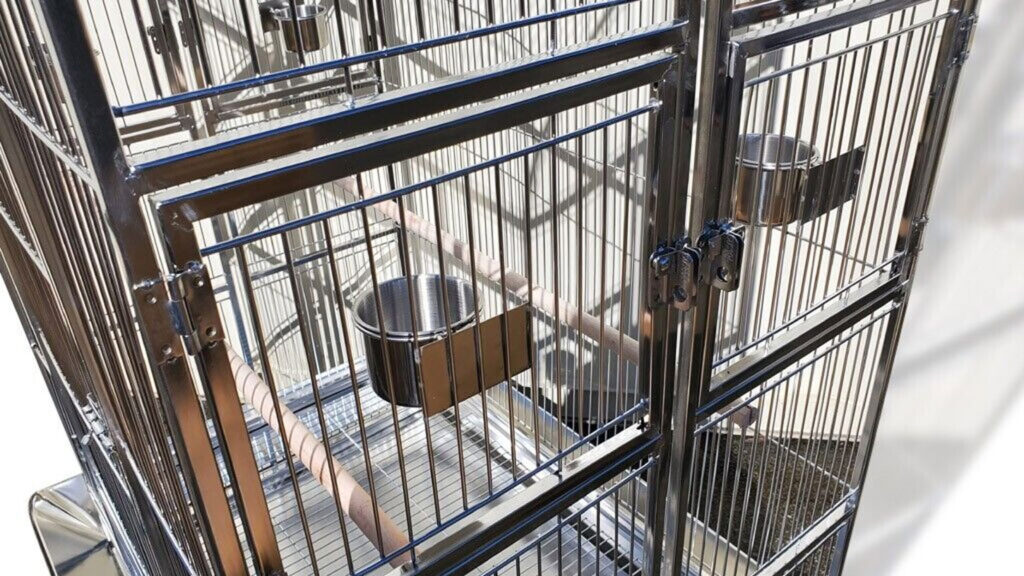The pros and cons of different bird cage materials are stainless steel cages, which are durable and non-toxic, offering good ventilation and plenty of room for birds to move around. Another option is acrylic cages, which provide an enhanced view of the bird but are less durable and restrict climbing opportunities.
Powder-coated steel cages are a popular choice that offers durability and comes in a variety of colours. However, they may chip or rust over time. Each material has its advantages and disadvantages, so it’s important to consider factors such as bird size, behaviour, and budget when selecting the best cage material.
Steel Bird Cages
| Steel Bird Cages |
|---|
|

Stainless Steel Bird Cages
Stainless steel bird cages are a popular choice due to their safe and non-toxic nature. They offer superior durability and resistance to corrosion, which ensures a long-lasting cage for your feathered friend. Additionally, stainless steel cages provide good ventilation for birds, allowing for proper airflow and a comfortable living environment.
The material is also easy to clean and maintain, making it convenient for bird owners. However, it’s important to note that stainless steel cages tend to be more expensive compared to other materials.
So, while they offer numerous benefits, it’s essential to consider your budget before making a decision. Overall, stainless steel bird cages are an excellent option for bird owners who prioritize safety and durability.
Acrylic Bird Cages
Acrylic bird cages are lightweight and easy to move around, offering convenience for both bird owners and their feathered friends. With good visibility, these cages allow birds to see outside and for owners to easily watch their pets. Additionally, acrylic is a safe material that is non-toxic to birds, ensuring their well-being.
However, it’s important to note that acrylic cages may not be as durable as steel or stainless steel cages. They have the tendency to scratch easily and may require frequent replacement.
Therefore, when considering an acrylic bird cage, it’s essential to weigh the pros and cons before making a purchase decision.
Frequently Asked Questions On The Pros And Cons Of Different Bird Cage Materials
What Material Should Bird Cages Be Made Of?
Bird cages are typically made of steel with an anticorrosive coating. Larger cages are often powder-coated or made of stainless steel, while cages for smaller birds may have plating, galvanizing, or plastic coating. The safest materials for bird cages are stainless steel, ceramic powder coating, and acrylic.
What Material Is Best For A Bird Cage Cover?
The best material for a bird cage cover is nylon twill shading fabric, as it provides adequate coverage and protection for the bird.
What Is The Safest Material For A Bird Cage?
The safest materials for a bird cage are stainless steel, ceramic powder coating, and acrylic. Make sure the bar spacing is wide enough to prevent your bird’s toes from getting stuck, but narrow enough to keep their head from going between the bars.
What Is The Best Type Of Bird Cage?
The best type of bird cage is a stainless steel cage. It is non-toxic, offers good ventilation, and provides plenty of room for the bird to move around. Nylon twill shading fabric can be used as a cover for the cage.
Other safe materials include ceramic powder coating and acrylic.
Conclusion
When choosing a bird cage material, it is important to consider the pros and cons of each option. Stainless steel is a popular choice due to its durability and non-toxicity. Acrylic cages offer an enhanced view but may not be as durable.
Powder-coated steel cages are also an option, but may not be as long-lasting. Ultimately, the best material for your birdcage depends on your needs and budget. Ensure the bar spacing is appropriate for your bird’s safety. Remember, investing in a high-quality cage is essential for your bird’s well-being.


